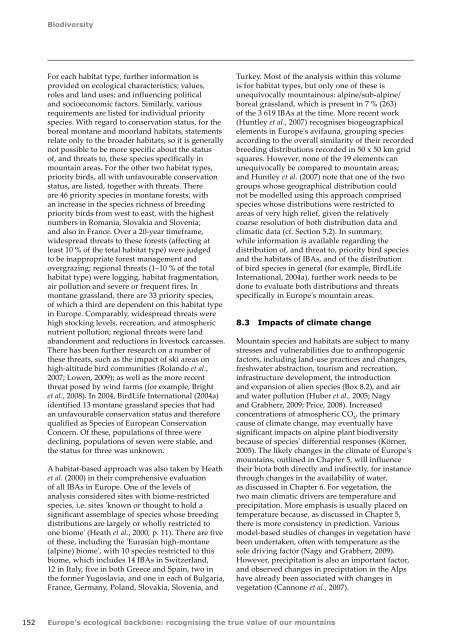Europes ecological backbone.pdf
Europes ecological backbone.pdf
Europes ecological backbone.pdf
Create successful ePaper yourself
Turn your PDF publications into a flip-book with our unique Google optimized e-Paper software.
Biodiversity<br />
For each habitat type, further information is<br />
provided on <strong>ecological</strong> characteristics; values,<br />
roles and land uses; and influencing political<br />
and socioeconomic factors. Similarly, various<br />
requirements are listed for individual priority<br />
species. With regard to conservation status, for the<br />
boreal montane and moorland habitats, statements<br />
relate only to the broader habitats, so it is generally<br />
not possible to be more specific about the status<br />
of, and threats to, these species specifically in<br />
mountain areas. For the other two habitat types,<br />
priority birds, all with unfavourable conservation<br />
status, are listed, together with threats. There<br />
are 46 priority species in montane forests, with<br />
an increase in the species richness of breeding<br />
priority birds from west to east, with the highest<br />
numbers in Romania, Slovakia and Slovenia;<br />
and also in France. Over a 20-year timeframe,<br />
widespread threats to these forests (affecting at<br />
least 10 % of the total habitat type) were judged<br />
to be inappropriate forest management and<br />
overgrazing; regional threats (1–10 % of the total<br />
habitat type) were logging, habitat fragmentation,<br />
air pollution and severe or frequent fires. In<br />
montane grassland, there are 33 priority species,<br />
of which a third are dependent on this habitat type<br />
in Europe. Comparably, widespread threats were<br />
high stocking levels, recreation, and atmospheric<br />
nutrient pollution; regional threats were land<br />
abandonment and reductions in livestock carcasses.<br />
There has been further research on a number of<br />
these threats, such as the impact of ski areas on<br />
high-altitude bird communities (Rolando et al.,<br />
2007; Lowen, 2009); as well as the more recent<br />
threat posed by wind farms (for example, Bright<br />
et al., 2008). In 2004, BirdLife International (2004a)<br />
identified 13 montane grassland species that had<br />
an unfavourable conservation status and therefore<br />
qualified as Species of European Conservation<br />
Concern. Of these, populations of three were<br />
declining, populations of seven were stable, and<br />
the status for three was unknown.<br />
A habitat-based approach was also taken by Heath<br />
et al. (2000) in their comprehensive evaluation<br />
of all IBAs in Europe. One of the levels of<br />
analysis considered sites with biome-restricted<br />
species, i.e. sites 'known or thought to hold a<br />
significant assemblage of species whose breeding<br />
distributions are largely or wholly restricted to<br />
one biome' (Heath et al., 2000, p. 11). There are five<br />
of these, including the 'Eurasian high-montane<br />
(alpine) biome', with 10 species restricted to this<br />
biome, which includes 14 IBAs in Switzerland,<br />
12 in Italy, five in both Greece and Spain, two in<br />
the former Yugoslavia, and one in each of Bulgaria,<br />
France, Germany, Poland, Slovakia, Slovenia, and<br />
Turkey. Most of the analysis within this volume<br />
is for habitat types, but only one of these is<br />
unequivocally mountainous: alpine/sub-alpine/<br />
boreal grassland, which is present in 7 % (263)<br />
of the 3 619 IBAs at the time. More recent work<br />
(Huntley et al., 2007) recognises biogeographical<br />
elements in Europe's avifauna, grouping species<br />
according to the overall similarity of their recorded<br />
breeding distributions recorded in 50 x 50 km grid<br />
squares. However, none of the 19 elements can<br />
unequivocally be compared to mountain areas;<br />
and Huntley et al. (2007) note that one of the two<br />
groups whose geographical distribution could<br />
not be modelled using this approach comprised<br />
species whose distributions were restricted to<br />
areas of very high relief, given the relatively<br />
coarse resolution of both distribution data and<br />
climatic data (cf. Section 5.2). In summary,<br />
while information is available regarding the<br />
distribution of, and threat to, priority bird species<br />
and the habitats of IBAs, and of the distribution<br />
of bird species in general (for example, BirdLife<br />
International, 2004a), further work needs to be<br />
done to evaluate both distributions and threats<br />
specifically in Europe's mountain areas.<br />
8.3 Impacts of climate change<br />
Mountain species and habitats are subject to many<br />
stresses and vulnerabilities due to anthropogenic<br />
factors, including land-use practices and changes,<br />
freshwater abstraction, tourism and recreation,<br />
infrastructure development, the introduction<br />
and expansion of alien species (Box 8.2), and air<br />
and water pollution (Huber et al., 2005; Nagy<br />
and Grabherr, 2009; Price, 2008). Increased<br />
concentrations of atmospheric CO 2<br />
, the primary<br />
cause of climate change, may eventually have<br />
significant impacts on alpine plant biodiversity<br />
because of species' differential responses (Körner,<br />
2005). The likely changes in the climate of Europe's<br />
mountains, outlined in Chapter 5, will influence<br />
their biota both directly and indirectly, for instance<br />
through changes in the availability of water,<br />
as discussed in Chapter 6. For vegetation, the<br />
two main climatic drivers are temperature and<br />
precipitation. More emphasis is usually placed on<br />
temperature because, as discussed in Chapter 5,<br />
there is more consistency in prediction. Various<br />
model-based studies of changes in vegetation have<br />
been undertaken, often with temperature as the<br />
sole driving factor (Nagy and Grabherr, 2009).<br />
However, precipitation is also an important factor,<br />
and observed changes in precipitation in the Alps<br />
have already been associated with changes in<br />
vegetation (Cannone et al., 2007).<br />
152 Europe's <strong>ecological</strong> <strong>backbone</strong>: recognising the true value of our mountains

















